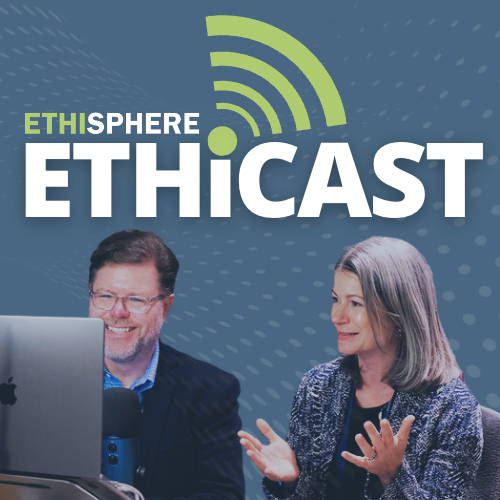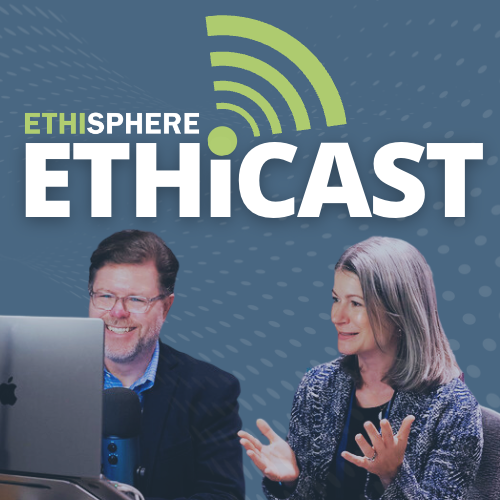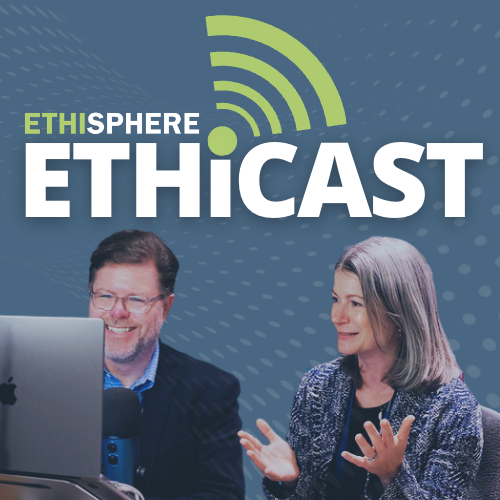[00:00:00] Speaker A: Hi everyone. Today we'll share more helpful insights for building a successful culture measurement strategy. I'm your host, Bill Coffin, and this is the Ethicast.
It's one thing to create rules and guidelines for people to follow and to enforce those mechanisms, but everyone in the ethics and compliance space knows that it is far more effective to build a culture of integrity and compliance where employees naturally want to do the right thing and see the value in behaving ethically. A lot of energy goes into building great organizational culture, but unless you regularly measure and analyze that culture, you'll never know how good it is or if it's delivering the results that you seek. In this episode, we'll hear from Ethisphere culture experts Emily Anderson, Katie Kruger, Doug Allen, and Curtis Light on some of the most important considerations around culture assessments, including what culture assessments really measure, how to apply demographic filters to culture data, how long cultural assessments should take, and the importance of training managers to boost your culture findings. Enjoy.
When you measure culture, what are you really measuring?
[00:01:21] Speaker B: I think there's kind of a layered approach to my answer.
The first layer is probably the most obvious one, which is employees familiarity with company culture, which for a lot of organizations will look like company resources, policies, procedures, codes. But really the more interesting measurements come when you start to evaluate employees perceptions of these things. So you might get employees telling you how effective they think their training is or how readable your codes are. And then the third piece, and it works really hand in hand with that second piece, is how your tools are actually informing your program. So employees might say that they think that the training is effective in certain ways. But when you take a survey of a whole population, you learn sort of about the broader effect of your training, of your code, of any of the policies and procedures that you have in place to protect your managers, your employees. And you start to pick out sort of the data that speaks to not only people's perceptions of things, but if you have codes directing what misconduct may or may not look like, what reporting should look like, what a speak up culture should look like. And then you have this data that tells you how often people are reporting, where they're reporting it to.
It allows you to paint a big picture that includes the resources, what employees think of the resources, and how those resources are actually directing the whole company culture itself.
[00:02:54] Speaker A: For companies that are going through it for the first time, are there any sets of data that they're usually surprised to see? Is there usually a kind of a common disconnect between what companies think they're Going to get back in a survey and what they actually get back.
[00:03:08] Speaker B: Yes. I think in my experience the most common surprise to them is how people are preferring to make reports of misconduct. And I think they're surprised for a couple of different reasons. One, organizations are putting a lot of company resources, often into building out platforms for people to make reports, whether this is web reporting, hotline reporting. But what the data really shows us is that people feel most comfortable making these types of reports to human beings and oftentimes to their managers. And so people are often surprised one, just by the fact that the resources used to build out this platform were not as effective as they hoped that they would be. Two, I think that people, organizations are surprised to learn that employees feel more comfortable making these reports to a human being, which points often to programs that have established ethics and compliance programs. It points to some of the gaps in those programs because if people are making a report to an automated system, there's usually a follow up procedure to that. That system goes somewhere and so there's somebody monitoring it or there's a hard copy for people to look at. But if it's more of a word of mouth reporting, you might learn that your managers don't know exactly what to do with those reports, or you might learn that people are speaking to their colleagues and colleagues don't know whether to take this as a venting session or if they should report to a manager. And so how people report is not only surprising because of the methods of reporting, but because it starts to sort of pull out some of the gaps in training and in the speakup culture in general.
[00:04:58] Speaker A: I can imagine a lot of companies, especially if they're undergoing their first survey, may go into it, or there's a temptation of going, you know what, we're going to have the survey done, but we're pretty confident that we've got a great system that works beautifully. And I'm sure the survey is just going to confirm everything that we think about it. There seems like a pretty good chance for there to be a bit of a surprise going, you know, what, we did not do as well as we thought we did, or things are not as great as we thought we did. Do you find that that's a common occurrence?
[00:05:25] Speaker B: Definitely. I think one of the greatest parts of my job is that I get to work with a lot of different organizations that are really passionate about creating a safe, reliable workplace for their employees. And so it's really disappointing when you, for them, when you've committed time, resources and a career to doing that, and maybe there are gaps in it, but I think that's the nature of the type of work that we do that is changing all of the time, that there are always going to be new gaps. And so I think it's important to sort of take that in stride and learn that a good program will be a flexible one. And so you might do this survey, you know, however many years in a row, and you're going to find new gaps. And that just kind of gives you a new. A new area to zone in on for the next year.
[00:06:19] Speaker A: When companies measure their culture, they often get data that captures the organization as a whole, but then it provides more specific information according to certain demographics within that population, such as race or gender, as I mentioned before. Why is it so important that organizations do this as part of a larger effort to measure culture?
[00:06:37] Speaker C: You know, when we measure culture, we're looking to see if the data tells a story of a question we're looking to answer. So, yeah, we collect race or gender as demographics. Often. Often I reference demographics more as some of the other things, such as, you know, business function or an employee's location within the broader organization and to collect demographics. I think there are two main reasons why an organization would do this. One is a larger effort paints a picture. But demographics tell the detailed story, right? Flying over an ocean gives a beautiful bird's eye view, but there's nothing like having your toes in the sand and digging into that sand can really tell us, you know, what is happening in those micro cultures within our organization.
And we all need to gain and retain the support for our ethics and compliance initiatives. You know, we all need the numbers to back up those things that we want to do, which I think leads to that second reason why it's worth collecting demographic information, really is because organizations have finite resources. And I think about this February, Bella asks Ethicast where Erica Salmon Byrne is talking about compliance training, suffering from the peanut butter approach. And she says something along the lines of, you know, you spread it thick and you spread it even that way, you know, everybody got what they needed to get.
But she goes on to say that sometimes you have to figure out how to satisfy knowing that everybody got what they needed without wanting to give out too much peanut butter. Not everybody always wants to eat your peanut butter sandwiches. And she thought that she beat that metaphor to death, but really it stuck with me, as I've done work with our clients here at Ethisphere. You know, it is that fine line between giving what's necessary and giving too much and everybody needs something different to be successful in life. Everybody needs something different in an organization. And it varies from person to person, from organization to organization.
But the thing that makes me think about this question is that, you know, I could take that metaphor even further. Peanut butter is getting expensive in this economy and it's not always possible to give everybody the same thing, the same amount of time, the same resources. Maybe senior leadership can't visit every pocket of the organization, but by collecting that demographic information, we can really see where we should be utilizing resources.
[00:09:31] Speaker A: What should they be really keeping in mind in terms of how long it takes to conduct an assessment? But then also all that, all that post assessment stuff that you just talked about, what kind of time commitment are they really looking at here? Because I can imagine companies might go into this thinking it's going to take X time, but. But really may take x times 2, x times 3.
[00:09:50] Speaker D: Yeah, it's such a great question, Bill, and I'll give you my very unsatisfactory answer. And that it depends, it depends on the type of organization in place. What are the ways and decisions are made? What sort of influence does the compliance team have internally to get things done? What's the relationship with HR and other on the ground stakeholders in sort of getting the message out in various modalities. A lot of factors are at play in terms of how long you should begin to think about in terms of preparing for measuring your own culture. So just some, some rules of thumb. I know when we partner with organizations that we usually allocate three months or so, three and a half months, 12 weeks, 14 weeks to ensure that we have enough time to sufficiently plan, measure and assess.
But looking back to the informed phase, so thinking through, okay, you've gone through the assessment, where we see a lot of organizations fall short is are you thinking through again strategically and how you take those data points and take those insights you've gathered and getting them into the right hands.
In thinking to that, Bill, we have a few different considerations I'd put in front of our audience to consider if they're in a similar position today. And so you've got several dimensions to keep track of. It's, you know, how soon can you get the information out to the various stakeholders? Who are these stakeholders and what's the required messaging for each? You can imagine where updating your board on what you found in your latest effort to measure speakup culture and the information you provide to them varies dramatically versus those that your divisional leaders get or that all employees will receive. And so we have we've developed a great resource that I is available to several of our members that illustrates sort of our approach in this regard. But Bill, if I can, I'll just touch on a few key points on audience you think of and sort of the time requirements for that. So I mentioned the board, but you know, one often overlooked group, and we've mentioned this before in other modalities, but is when you do measure your speak up culture, don't neglect turning that information around and putting it back in the hands of your entire workforce really as soon as you can. And we don't mean give them and give everyone a full readout of what you found, but really make sure that you capitalize on the effort you just undertook and get some key opportunity data, get some key insights, get some summary findings from that effort, put it back into the employees hands and really take that opportunity to thank them for speaking out, speaking up and participating in this effort. A lot of times we hear organizations are leaning heavily on surveys as a mechanism by following up with all employees who did have a chance to partake and quite frankly be candid in their responses, hopefully in that they are answering a question that could be considered sensitive and that we're asking you about speaking up comfortably. And what do you think about your manager? What do you think about senior leadership? Really take the time to thank them, right? Ensure them that you know, we received your message, thank you for participating. Here's what we saw, here's what you told us. Here's if you're ready to make this proclamation, here's what we plan on doing about it. Here's some suggestions of where we want to take this information and make ourselves a better, a better place to work, a better place to be. And you can imagine, Bill, that gives employees a sense of comfort in that. Okay, I've been heard. And then secondly, as organizations think to measure in the future, employees remember this and so they'll. It builds goodwill for future efforts to measure, knowing that, that when they do speak up and participate that they will be heard and things will change.
[00:13:20] Speaker A: You laid out just how important the manager's role is in being that arbiter of culture. How much of a, of a onus does this put on the organization to make sure that their managers are adequately trained to really be that front line of culture? And what kind of training do they typically require in this?
[00:13:37] Speaker E: It's a big piece of it. And managers, we kind of feel like they're, they're kind of like the heart of your culture. They, they're the big lever that you can pull to affect cultural change. So when you're thinking about your managers, I always like to think about how they're asked to do a lot. They're asked to do a lot from different departments.
They are asked to do a lot from their direct reports. Their manager, of course. So it's important when we're thinking about training managers to have these conversations to remember that their time is scarce. So when we're talking about, hey, can you have more of these conversations?
I always like to think about can we incorporate this conversation into something else that's already happening? Maybe it's a weekly team meeting, maybe it's during their one on ones with their direct reports. It doesn't always have to be a brand new thing thing. We don't always have to reinvent the wheel in that way.
But it's important to remember that managers are asked to do a lot and so gaining even five minutes of their time to have a conversation could be difficult. And so that's, that's certainly something to look into if you're measuring culture and you're not seeing the conversation rates that you would like. Also if you're seeing just poor perceptions of of managers in general, is what's that hiring process look like? Is ethics and compliance a piece of that is just something to look into.
[00:15:08] Speaker A: For a wealth of free reports, presentations, webinars and more around ethical culture, please visit the Ethisphere resource
[email protected] resources. And while you're there, please help yourself to a copy of the eight Pillars of an Ethical Culture, our special report that describes the most important aspects of a culture of integrity, including perceptions of the ethics and compliance function, pressure, organizational justice, and more. And finally, to connect with the at the Sphere Culture team and learn how you can measure and elevate your organization's culture, please visit ethisphere.com solutions. I'm Bill Coffin and this has been the Ethicast. For more episodes, please Visit the Ethisphere YouTube
[email protected] ethisphere and if this is your first time enjoying the show, please make sure to like and subscribe on YouTube, Apple Podcasts and Spotify. Thanks for joining us. And until next time, remember, strong ethics is good business.


